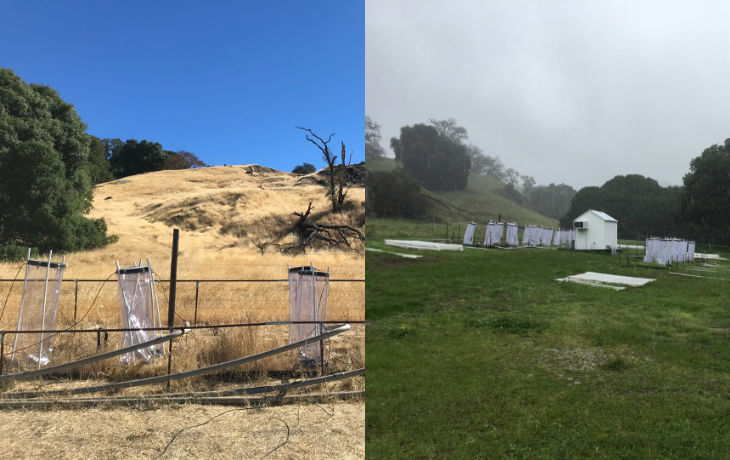Plant & Microbial Biology graduate student Alexa Nicolas researches soil microbiomes in the labs of Environmental Science, Policy, and Management professor Mary Firestone and Plant and Microbial Biology professor Michi Taga. In this research spotlight, Nicolas shares her new findings on soil viruses—an abundant and ubiquitous member of the microbiome—and their link to carbon emissions.

For her research Nicolas measured carbon dioxide emissions from soil as her field sites transitioned from the dry season (left) to the wet season (right).
There is a magical moment in California when the first rainfall hits the soil. During this boundary between the dry season and the wet season, soils release a disproportionate amount of carbon dioxide into the atmosphere. For ESPM professor Mary Firestone's group, this has been a fruitful system to understand the impact of the soil microbiome on soil CO2 release. Over the past decade, the Firestone lab has illuminated that the "wet-up" of dry soil leads to different types of microbes responding at different rates—microbial succession; simultaneously, wet-up leads to a massive moment of death for many microbes.
While soil viruses are abundant and ubiquitous, the role of viruses in the soil microbiome has remained elusive. As a graduate student in the Department of Plant and Microbiology working in the Firestone lab, I hypothesized that viruses would awaken at this special moment and become a major driver of the observed microbial death.
However, our research found the reality to be much more complicated. Recently, DNA and RNA sequencing techniques have uncovered the incredible diversity of soil viruses and the many varied functions they can do, but how that has impacted the resident microbes in soil has been an open question. We applied a novel combination of advanced sequencing techniques and isotopes to hunt down active viruses and their hosts and found that rather than viruses controlling hosts, viruses seem to follow their hosts through time. Using these techniques, we also found that during wet-up, viruses contribute a steady rate to the death of microbes that underlies the release of CO2 to the atmosphere.
A pre-print of our study is available on BioRxiv. Additional co-authors include Professor Michi Taga in PMB; Ella T. Sieradzki and Professor Jill Banfield, both in ESPM; and Jennifer Pett-Ridge and Steven J. Blazewicz (corresponding authors of the study), both at Lawrence Livermore National Laboratory.
